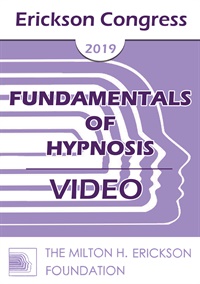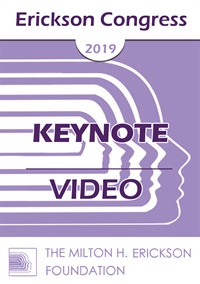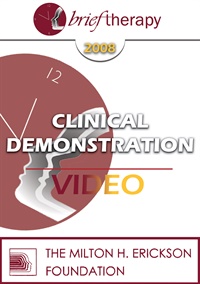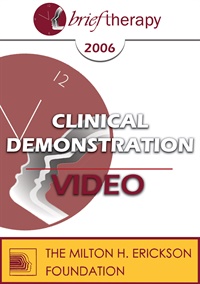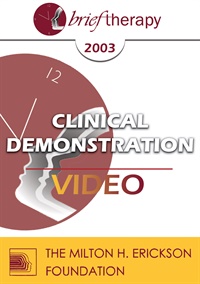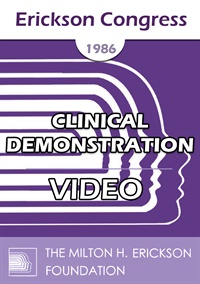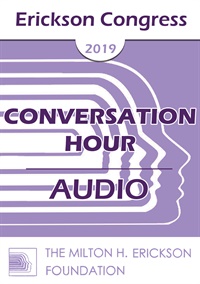
- Average Rating:
- Not yet rated
- Topic Areas:
- Conversation Hours | Hypnosis | Trance | Ideomotor
- Categories:
- Erickson Congress | Erickson Congress 2019
- Faculty:
- Stephen Lankton, MSW
- Duration:
- 54 Minutes
- Format:
- Audio Only
- Original Program Date:
- Dec 14, 2019
- Short Description:
- Often students use hypnosis as a context for creating a safe or comfortable state of mind, suggesting away symptoms, or uncomplicated ego-strengthening by bolstering encouragement. This is little more than psycho-education done in trance. But hypnosis offers opportunities for far more therapeutic intervention. This open discussion format will help participants dig into this area and develop some expanded possibilities for therapy during hypnosis.
- Price:
- $15.00 - Base Price
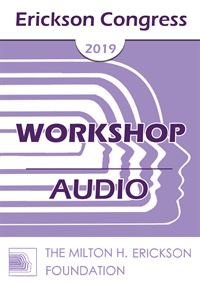
- Average Rating:
- Not yet rated
- Topic Areas:
- Workshops | Brief Therapy | Hypnosis | Experiential Therapy
- Categories:
- Erickson Congress | Erickson Congress 2019
- Faculty:
- Stephen Lankton, MSW
- Duration:
- 2 Hours 3 Minutes
- Format:
- Audio Only
- Original Program Date:
- Dec 13, 2019
- Short Description:
- This workshop will teach six positive techniques that actually make Ericksonian experiential hypnosis successful. Dysfunctional families fail to teach children how to use their experiences to succeed. Consequently, clients learn dozens of self-defeating habits and later present in our offices as adults with depression, anxiety, phobias, etc. The desire to change, insight, and motivation do not counteract those habits - nor does hypnotic suggestion create such change. Experience is the key to cure.
- Price:
- $15.00 - Base Price
- Average Rating:
- Not yet rated
- Topic Areas:
- Fundamentals of Hypnosis | Indirection | Hypnosis | Language of Hypnosis | Yes Set
- Categories:
- Erickson Congress | Erickson Congress 2019
- Faculty:
- Stephen Lankton, MSW
- Course Levels:
- Master Degree or Higher in Health-Related Field
- Duration:
- 1 Hour 52 Minutes
- Format:
- Audio and Video
- Original Program Date:
- Dec 13, 2019
- Short Description:
- The rationale and basic research regarding the use of indirection will be presented. Participants will be guided through several exercises to help them learn and practice the construction of 4 fundamental forms of suggestions and 3 therapeutic binds. A demonstration using these forms will illustrate the implementation of these language techniques for both the induction and therapy.
- Price:
-
Sale is $29.00
price reduced from Base Price - $59.00
- Average Rating:
- Not yet rated
- Topic Areas:
- Keynotes | Ericksonian Hypnosis and Therapy Techniques | History of Psychotherapy | Metaphors | Utilization | Experiential Therapy | Unconscious Processes
- Categories:
- Erickson Congress | Erickson Congress 2019
- Faculty:
- Stephen Lankton, MSW
- Course Levels:
- Master Degree or Higher in Health-Related Field
- Duration:
- 54 Minutes
- Format:
- Audio and Video
- Original Program Date:
- Dec 12, 2019
- Short Description:
- Dr. Milton Erickson graduated from the University of Wisconsin’s School of Medicine in 1925. During the ensuing 55 years of his career, Erickson was devoted to researching, practicing, learning, refining, teaching, and publishing the lessons borne of his creative intuition and experience. And over the years his practices evolved. The last two decades of his life, and even more so in the 40 years since his death, through the efforts of those he influenced the number of ideas and interventions attributed to Erickson proliferated abundantly.
- Price:
-
Sale is $29.00
price reduced from Base Price - $59.00
BT08 Clinical Demonstration 07 - Using Hypnosis in a Brief Therapy Demo - Stephen Lankton, MSW, DAHB
- Average Rating:
- Not yet rated
- Topic Areas:
- Clinical Demonstrations | Brief Therapy | Hypnosis
- Categories:
- Brief Therapy Conference | Brief Therapy Conference 2008
- Faculty:
- Stephen Lankton, MSW
- Course Levels:
- Master Degree or Higher in Health-Related Field
- Duration:
- 58:19
- Format:
- Audio and Video
- Original Program Date:
- Dec 13, 2008
- Short Description:
- BT08 Clinical Demonstration 07 - Using Hypnosis in a Brief Therapy Demo - Stephen Lankton, MSW, DAHB
- Price:
-
Sale is $29.00
price reduced from Base Price - $59.00

- Average Rating:
- Not yet rated
- Topic Areas:
- Workshops | Brief Therapy | Hypnosis | Psychotherapy
- Categories:
- Brief Therapy Conference | Brief Therapy Conference 2008
- Faculty:
- Stephen Lankton, MSW
- Duration:
- 2:53:37
- Format:
- Audio Only
- Original Program Date:
- Dec 12, 2008
- Short Description:
- Research shows that brief treatments paired with hypnosis is more effective than treatments alone for many types of problems. The science and art of hypnosis is now widely recognized as a component tool for psychotherapy and has been employed successfully as a comfortable part of private practice and agency practice for years. As hypnosis spreads throughout the mainstream of psychotherapy, it is important to get competent information regarding its use. This workshop is intended to correct any lack of understanding and training in this important area. The rationale, indications and basic use will be explained and demonstrated with practical exercises to help convey the key language skills that are requisite.
- Price:
- $15.00 - Base Price
- Average Rating:
- Not yet rated
- Topic Areas:
- Fundamentals of Hypnosis | Hypnosis | Language of Hypnosis | Indirection
- Categories:
- Brief Therapy Conference | Brief Therapy Conference 2008
- Faculty:
- Stephen Lankton, MSW
- Course Levels:
- Master Degree or Higher in Health-Related Field
- Duration:
- 2:09:12
- Format:
- Audio and Video
- Original Program Date:
- Dec 12, 2008
- Short Description:
- The rationale for the use of indirection will be presented. In this session you will learn and practice the construction of fundamental forms of indirection language. Participants will practice five forms of indirect suggestions and three forms of binds. A demonstration using these forms will illustrate the implementation of this set of language techniques for the induction and treatment process. The use of indirect suggestions in further treatment will be outlined.
- Price:
- $29.00 - Base Price
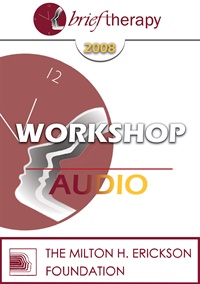
- Average Rating:
- Not yet rated
- Topic Areas:
- Workshops | Utilization | Brief Therapy | Self-Image Thinking | Resources
- Categories:
- Brief Therapy Conference | Brief Therapy Conference 2008
- Faculty:
- Stephen Lankton, MSW
- Duration:
- 2:19:24
- Format:
- Audio Only
- Original Program Date:
- Dec 11, 2008
- Short Description:
- Three specific techniques are universally valuable in brief therapy: utilization, experience resource retrieval, experiential-based imagery rehearsal. This workshop provides an exposure to these concepts and techniques with clear examples and demonstrations. Participants should find numerous ways to enhance their brief therapy practice in any setting and with all populations of clients.To list the essential aspects of the utilization approach for reducing resistance across multiple settings.
- Price:
- $15.00 - Base Price
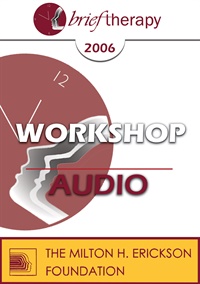
- Average Rating:
- Not yet rated
- Topic Areas:
- Workshops | Brief Therapy | Hypnosis | Psychotherapy
- Categories:
- Brief Therapy Conference | Brief Therapy Conference 2006
- Faculty:
- Stephen Lankton, MSW
- Duration:
- 2:37:19
- Format:
- Audio Only
- Original Program Date:
- Dec 10, 2006
- Short Description:
- Research shows that treatment paired with hypnosis is more effective than treatment alone for many types of problems. The science and art of hypnosis is now widely recognized as a component tool for psychotherapy and has been employed successfully as a comfortable part of private practice and agency practice for years. As hypnosis spreads into the mainstream of psychotherapy, it is important to get competent information regarding its use. Lacking that, many practitioners do not make use of the advantages it provides as an adjunct to a well-rounded set of clinical skills. This workshop is intended to correct that lack of understanding and training in this important area. The rationale, indications and basic use will be explained and demonstrated with practical exercises to help convey the key language skills that are requisite.
- Price:
- $15.00 - Base Price
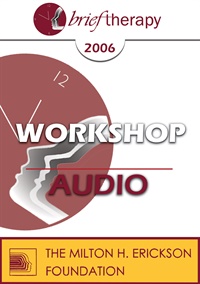
- Average Rating:
- Not yet rated
- Topic Areas:
- Workshops | Brief Therapy | Ericksonian Hypnosis and Therapy Techniques | Footprinting | Goals of the Therapist | Reframing | Utilization
- Categories:
- Brief Therapy Conference | Brief Therapy Conference 2006
- Faculty:
- Stephen Lankton, MSW
- Duration:
- 1:44:18
- Format:
- Audio Only
- Original Program Date:
- Dec 09, 2006
- Short Description:
- The Basic Foot Print is a process model of change in therapy that represents and identifies Erickson's method for change. It is a general umbrella under which we should be able to place any step of change or intervention. Encounters that follow the Basic Foot Print create change and any therapy that steps through these stages reflects Dr. Erickson's approach and echoes his legacy. The steps are: matching/connecting, blending, utilizing, introducing ambiguity (disrupting stasis), reframing and co-creating outcomes. An in-depth understanding of steps within the Basic Footprint will be taught, demonstrated and practiced.
- Price:
- $15.00 - Base Price
- Average Rating:
- Not yet rated
- Topic Areas:
- Clinical Demonstrations | Hypnosis | Psychotherapy | Brief Therapy
- Categories:
- Brief Therapy Conference | Brief Therapy Conference 2006
- Faculty:
- Stephen Lankton, MSW
- Course Levels:
- Master Degree or Higher in Health-Related Field
- Duration:
- 54:30
- Format:
- Audio and Video
- Original Program Date:
- Dec 08, 2006
- Short Description:
- BT06 Clinical Demonstration 10 - Introducing Hypnosis into Psychotherapy - Stephen Lankton, MSW, DAHB
- Price:
-
Sale is $29.00
price reduced from Base Price - $59.00
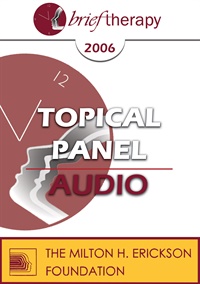
- Average Rating:
- Not yet rated
- Topic Areas:
- Topical Panels | Art and Creativity | Psychotherapy | Brief Therapy
- Categories:
- Brief Therapy Conference | Brief Therapy Conference 2006
- Faculty:
- Stephen Lankton, MSW | Scott Miller, PhD | Erving Polster, PhD | Frances Vaughan, PhD
- Duration:
- 59:19
- Format:
- Audio Only
- Original Program Date:
- Dec 08, 2006
- Short Description:
- BT06 Topical Panel 02 - Psychotherapy: Art or Science? - Stephen Lankton, MSW, DAHB, Scott Miller, PhD, Erving Polster, PhD, Frances Vaughan, PhD
- Price:
- $15.00 - Base Price
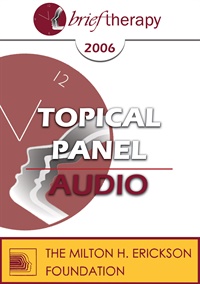
- Average Rating:
- Not yet rated
- Topic Areas:
- Topical Panels | Brief Therapy | Milton Erickson
- Categories:
- Brief Therapy Conference | Brief Therapy Conference 2006
- Faculty:
- Betty Alice Erickson, MS, LPC, LMFT | Stephen Gilligan, PhD | Stephen Lankton, MSW | Ernest Rossi, PhD
- Duration:
- 1:04:06
- Format:
- Audio Only
- Original Program Date:
- Dec 08, 2006
- Short Description:
- BT06 Topical Panel 07 - About Milton H. Erickson - Betty Alice Erickson, MS, Stephen Gilligan, PhD, Stephen Lankton, MSW, DAHB, Ernest Rossi, PhD
- Price:
- $15.00 - Base Price
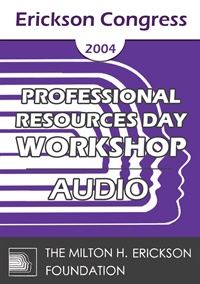
- Average Rating:
- Not yet rated
- Topic Areas:
- Workshops | Therapist Development | Self-Care
- Categories:
- Erickson Congress | Erickson Congress 2004
- Faculty:
- Stephen Lankton, MSW | Kathleen Donaghy
- Duration:
- 1:40:55
- Format:
- Audio Only
- Original Program Date:
- Dec 01, 2004
- Short Description:
- This workshop leads participants in exercises which will unravel the cognitive-emotional mechanism of self-sabotage. The focus is aimed at strengthening participants' automatic associations to resources even in times of low motivation and self-imposed excuses to avoid success.
- Price:
- $15.00 - Base Price
- Average Rating:
- Not yet rated
- Topic Areas:
- Clinical Demonstrations | Pain and Healing | Brief Therapy | Hypnosis | Trance
- Categories:
- Brief Therapy Conference | Brief Therapy Conference 2003
- Faculty:
- Stephen Lankton, MSW
- Course Levels:
- Master Degree or Higher in Health-Related Field
- Duration:
- 59:27
- Format:
- Audio and Video
- Original Program Date:
- Dec 12, 2003
- Short Description:
- Educational Objectives: 1) To describe the use of three trance phenomena in the reduction of pain. 2) To describe how hypnosis for pain control can be introduced in brief therapy.
- Price:
-
Sale is $29.00
price reduced from Base Price - $59.00
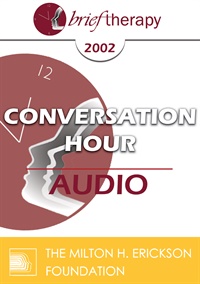
- Average Rating:
- Not yet rated
- Topic Areas:
- Conversation Hours | Brief Therapy
- Categories:
- Brief Therapy Conference | Brief Therapy Conference 2002
- Faculty:
- Stephen Lankton, MSW
- Duration:
- 1:05:59
- Format:
- Audio Only
- Original Program Date:
- Dec 13, 2002
- Short Description:
- BT02 Conversation Hour 08 - Stephen Lankton, MSW, DAHB
- Price:
- $15.00 - Base Price
Tags: Brief Therapy Stephen Lankton
- Average Rating:
- Not yet rated
- Topic Areas:
- Clinical Demonstrations | Family Therapy | Hypnosis
- Categories:
- Erickson Congress | Erickson Congress 1986
- Faculty:
- Stephen Lankton, MSW
- Course Levels:
- Master Degree or Higher in Health-Related Field
- Duration:
- 1:01:21
- Format:
- Audio and Video
- Original Program Date:
- Dec 05, 1986
- Short Description:
- IC86 Clinical Demonstration 06 - Family Therapy and Hypnosis - Stephen R Lankton, ACSW
- Price:
- $29.00 - Base Price
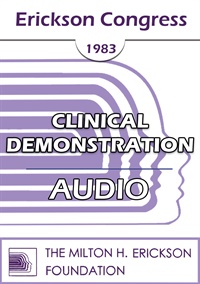
- Average Rating:
- Not yet rated
- Topic Areas:
- Clinical Demonstrations | Pain and Healing | Phenomenology | Hypnotic Phenomena | Trance | Hypnosis
- Categories:
- Erickson Congress 1983 | Erickson Congress
- Faculty:
- Stephen Lankton, MSW
- Duration:
- 58:48
- Format:
- Audio Only
- Original Program Date:
- Nov 28, 1983
- Short Description:
- IC83 Clinical Demonstration 27 - Clinical Use of Trance Phenomena for Therapy and Pain Control - Stephen R Lankton, ACSW
- Price:
- $15.00 - Base Price


